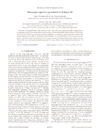Identificador persistente para citar o vincular este elemento:
https://accedacris.ulpgc.es/jspui/handle/10553/75664
| Campo DC | Valor | idioma |
|---|---|---|
| dc.contributor.author | Fernández Hevia, Daniel | en_US |
| dc.contributor.author | Stampfl, Catherine | en_US |
| dc.contributor.author | Viñes, Francesc | en_US |
| dc.contributor.author | Illas, Francesc | en_US |
| dc.date.accessioned | 2020-11-18T09:28:50Z | - |
| dc.date.available | 2020-11-18T09:28:50Z | - |
| dc.date.issued | 2013 | en_US |
| dc.identifier.issn | 1098-0121 | en_US |
| dc.identifier.other | WoS | - |
| dc.identifier.uri | https://accedacris.ulpgc.es/handle/10553/75664 | - |
| dc.description.abstract | In contrast to a long held belief, it has been shown that n-type AlN can be achieved through Si-doping. This is unexplainable from the current theoretical understanding, a situation that hinders further progress in AlN-based ultraviolet (UV) technologies. From first-principles calculations, we find that n-type behavior arises under N-rich growth conditions due to high Si solubility and to the formation of V Al-bound Si clusters. We show that metal-rich growth may lead to weak n-type behavior due to oxygen impurities binding and deactivating cation vacancies. We provide clues for designing production processes for n-type AlN as a base material for potential new UV sources. | en_US |
| dc.language | eng | en_US |
| dc.relation | Efesot-Eficiencia Energética en Protección Contra Sobretensiones | en_US |
| dc.relation | Cascada-Cambiador de Tomas en Carga Para Redes de Distribución Activa de Energía Eléctrica. | en_US |
| dc.relation.ispartof | Physical Review B - Condensed Matter and Materials Physics | en_US |
| dc.source | Physical Review B [ISSN 1098-0121], v. 88 (8), 085202, (Agosto 2013) | en_US |
| dc.subject | 3303 ingeniería y tecnología químicas | en_US |
| dc.subject.other | Molecular-Beam Epitaxy | en_US |
| dc.subject.other | Conduction | en_US |
| dc.subject.other | Alxga1-Xn | en_US |
| dc.subject.other | Donor | en_US |
| dc.subject.other | Gan | en_US |
| dc.subject.other | Impurities | en_US |
| dc.subject.other | Nitrides | en_US |
| dc.subject.other | Defects | en_US |
| dc.title | Microscopic origin of n-type behavior in Si-doped AlN | en_US |
| dc.type | info:eu-repo/semantics/Article | en_US |
| dc.type | Article | en_US |
| dc.identifier.doi | 10.1103/PhysRevB.88.085202 | en_US |
| dc.identifier.isi | 000322913200004 | - |
| dc.identifier.eissn | 1550-235X | - |
| dc.identifier.issue | 8 | - |
| dc.relation.volume | 88 | en_US |
| dc.investigacion | Ciencias | en_US |
| dc.type2 | Artículo | en_US |
| dc.contributor.daisngid | 3261521 | - |
| dc.contributor.daisngid | 153051 | - |
| dc.contributor.daisngid | 393276 | - |
| dc.contributor.daisngid | 14679 | - |
| dc.description.numberofpages | 6 | en_US |
| dc.utils.revision | Sí | en_US |
| dc.contributor.wosstandard | WOS:Hevia, DF | - |
| dc.contributor.wosstandard | WOS:Stampfl, C | - |
| dc.contributor.wosstandard | WOS:Vines, F | - |
| dc.contributor.wosstandard | WOS:Illas, F | - |
| dc.date.coverdate | Agosto 2013 | en_US |
| dc.identifier.ulpgc | Sí | en_US |
| dc.description.sjr | 2,804 | |
| dc.description.jcr | 3,664 | |
| dc.description.sjrq | Q1 | |
| dc.description.jcrq | Q1 | |
| item.grantfulltext | open | - |
| item.fulltext | Con texto completo | - |
| crisitem.project.principalinvestigator | Pérez Peña, Jesús | - |
| crisitem.project.principalinvestigator | Pérez Peña, Jesús | - |
| Colección: | Artículos | |
Citas de WEB OF SCIENCETM
Citations
22
actualizado el 08-jun-2025
Visitas
92
actualizado el 14-dic-2024
Descargas
186
actualizado el 14-dic-2024
Google ScholarTM
Verifica
Altmetric
Comparte
Exporta metadatos
Los elementos en ULPGC accedaCRIS están protegidos por derechos de autor con todos los derechos reservados, a menos que se indique lo contrario.
